The Best Street Food in Shibuya According to Locals: 5 Hidden Spots
“The real voyage of discovery is not in seeing new places, but in seeing with new eyes.” ~ Marcel Proust. Where can you find the best street food in Shibuya away from the touristy spots? Boasting the world’s busiest...

“The real voyage of discovery is not in seeing new places, but in seeing with new eyes.” ~ Marcel Proust.
Where can you find the best street food in Shibuya away from the touristy spots?
Boasting the world’s busiest pedestrian crossing, it’s no surprise that Shibuya rates highly on any visitors’ Tokyo itinerary. But, it is a mighty big (and often crowded) neighbourhood!
Not only is Shibuya a horizontal neighbourhood, it’s also a vertical one. Mouth-watering aromas waft through an expanse of narrow laneways, while multi-level buildings filled with stores and all kinds of eateries (both above and below ground) dominate the landscape.
At first, it can be overwhelming to know where to find the best Shibuya street food. You could just randomly hit the streets and follow your nose, but wouldn’t it be great to remove some of the guesswork and get inside the mind of a local to know exactly where to go?
Having visited over half a dozen times, Shibuya is one of my favourite Tokyo neighbourhoods. Always longing to blend in in Japan and explore beyond what’s on the surface, I was delighted to eat my way around the area on a Shibuya street food tour recently and see this favourite ol’ spot of mine from a fresh new perspective.
Buried beneath the glassy skyscrapers of today’s modern age, there is still old-world charm to be found in Shibuya. If you want to delve deeper and uncover 5 top foodie spots according to locals, read on for more!
This guide to the best street food in Shibuya will cover:
Who are Arigato Japan Tours? Where to eat in Shibuya: Best street food according to locals Learning meaningful histories of things hiding in plain sight Experiencing a stand-up sushi bar Stocking up on dagashi Dining at a little-known yakiniku restaurant Discovering old and new yokocho Crossing the Scramble and through the Centre-Gai Enjoying a Showa Era okonomiyaki restaurant Finishing with a traditional Japanese street food dessert Overall thoughts & how to book your own Shibuya food tourI experienced this Shibuya street food tour as a press invite. As always, all thoughts and opinions are my own. This post contains affiliate links, at no extra cost to you. I may earn a small commission if you click through and make a purchase.
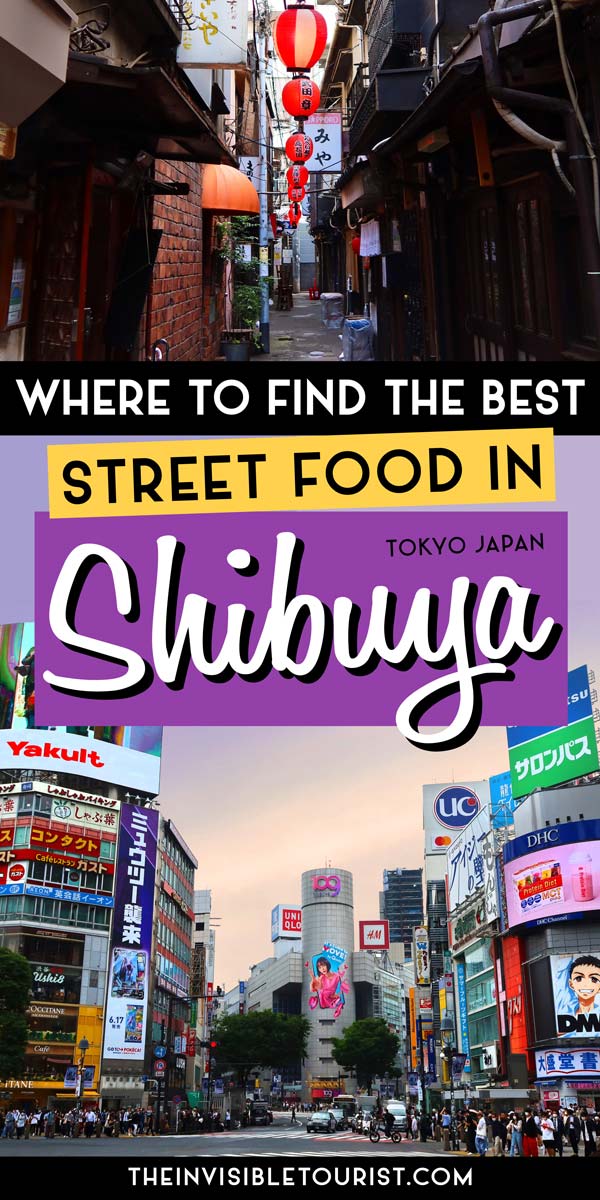 Pin me to Pinterest for reference later! 📌
Pin me to Pinterest for reference later! 📌Who are Arigato Japan Tours?
I was invited by Arigato Japan Tours to enjoy this delicious experience. Specialising in small group tours with a focus on culturally significant foods and drinks throughout Japan, Arigato Japan Tours help connect visitors with local businesses in a meaningful way.
I’m very passionate about this win-win situation for tourists and locals, as it’s an essential part of blending in in Japan. It’s also one of the reasons why I wrote a book on this subject and I created my Japan travel blog to help you achieve this.
My local guide for this Shibuya street food tour was Norma, she’s lived in Japan for 7 years. Sharing a love of art and history, we immediately hit it off!
You can simply let Arigato Japan know your preferences, dietary requirements or any allergies at the time of booking. I liked that this tour was suited to my tastes, so the eateries you visit may slightly differ to mine.

Where to eat in Shibuya: Best street food in Shibuya according to locals
While I am quite familiar with the regular places in Shibuya, numerous things have gone and others have popped up since March 2020. This is a neighbourhood that can change VERY rapidly so it helps to have some local knowledge.
Learning meaningful histories of things hiding in plain sight
I first met Norma by the Hachiko Family Mural, directly outside JR Shibuya Station. If you’re not familiar with the story of this beloved dog, your guide will fill you in about why the accompanying bronze statue nearby has become a popular meeting point in Shibuya.
TIP: Although I already knew Hachiko’s story, Norma shared some little-known facts about him with me – and something I hadn’t heard before about the statue during WWII.
As we moved indoors, Norma pointed out a huge mural that thousands upon thousands of people walk directly past each day without really noticing it. The story behind this one is so fascinating, I’ll let your guide share its remarkable history!
Then, we were able to catch a glimpse of Shibuya Crossing (aka the Shibuya “Scramble”) from an elevated vantage point. If you’re after some free places to view it from above, your guide will let you in on some spots you wouldn’t have thought of.


Experiencing a stand-up sushi bar
Heading outdoors into the narrow laneways, Norma revealed to me a connection between freezer (refrigerator) lockers and Pachinko parlours – I swear Japan thinks of everything!
Keeping in with old traditions, our first stop on this street food in Shibuya tour was a stand-up sushi bar. As the name suggests, there are no seats. The idea is customers come and go quickly.
A small circular bar with three chefs working away in the centre, Norma ordered us four different types of sushi made on the spot from fresh local ingredients on display.
I try to keep an open mind and be a little more adventurous with food in Japan than I am at home, purely because most things just taste better! For instance I don’t eat pork, but in Japan I won’t shy away from it.
However, I’m personally not a fan of sashimi (raw fish/meat), so I let Norma know and she tailored my orders to suit.

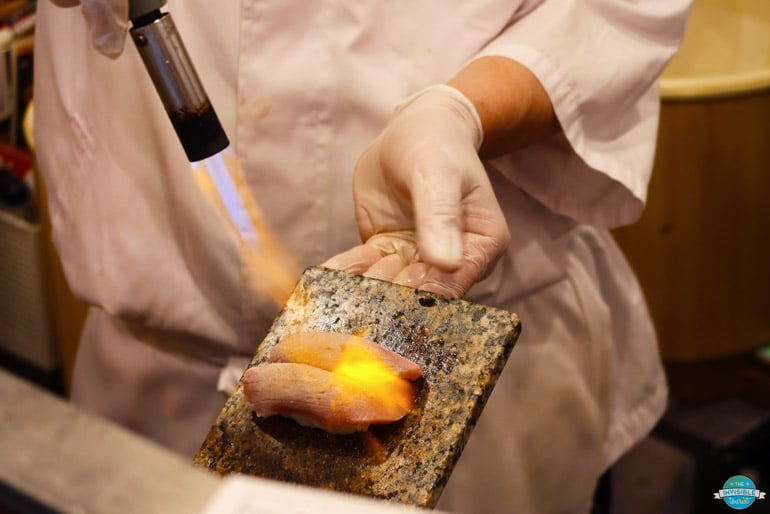
Norma reminded me of the correct etiquette when it comes to eating sushi ずし. I had the pleasure of indulging in the following specialties, all served on a little tender bed of boiled rice:
 Different types of sushi: 1) Tuna nigiri ~ 2) Flounder nigiri ~ 3) Salmon nigiri ~ 4) Eel temaki
Different types of sushi: 1) Tuna nigiri ~ 2) Flounder nigiri ~ 3) Salmon nigiri ~ 4) Eel temaki
Stocking up on dagashi
As I explain in my guide to snacks from Japan, dagashi are cheap snacks and sweets aimed at school-aged children. They only cost a few yen each, as children would spend their pocket money at dagashi stores on the way home from school during the Showa Period (1926 – 1989).
Being a big kid at heart, I absolutely ADORE dagashi and make sure to buy a bag full whenever I visit Penny Candy lane in the old town of Kawagoe!
At our next location, I was able to select a nice little bounty of dagashi to save for afterwards. There were shelves upon shelves to choose from, it wasn’t easy for me to narrow them down as I wanted to try them all.
Then, passing by Shibuya’s infamous Love Hotel Hill area, Norma pointed out an interesting type of hotel here I’m sure you haven’t seen before.
We also went by a popular store with locals and visitors alike – this is the flagship branch and the biggest in Tokyo!

Dining at a little-known yakiniku restaurant
I love yakiniku eateries as they serve my favourite Japanese food! These are where you order meat and vegetable dishes to cook yourself on a small grill in the table centre. It’s a fun social experience you should try at least once in Japan (or even if you’re travelling solo).
TIP: The best part? After my tour I discovered this place currently isn’t even on Google Street View, so unless you have local knowledge you’d likely never find it searching by yourself!
I thoroughly enjoyed the variety of different meats and vegetables Norma ordered, just check out that wagyu beef sizzling away in my photos below – simply divine. I also learnt why cucumber and miso were traditionally favoured by people making the arduous climb to Mt Fuji’s summit.


Discovering old and new yokocho
After our yakiniku mini-feast, Norma led me through more streets and laneways until we reached Miyashita Park. Complete with a rooftop park, this complex is the brand-spanking new kid on the Shibuya block, bursting with retail stores and countless eateries.
I’ve seen it being built since 2014 and usually covered in scaffolding, so it was wild to finally see it completed!
As always in Japan – the “Land of Contrasts” as I like to call it – there is something old just around the corner to juxtapose the new. Further along the train line and hidden away from sight unless you know is a charming Showa-era alleyway named Nonbei Yokocho.
Norma explained that with the introduction of Miyashita Park and its fresh new yokocho (alleyway of eateries and bars), locals were worried it was going to overshadow and eventually drown out the old Nonbei Yokocho. But thankfully, it hasn’t and this traditional laneway is still very-well loved!
TIP: Can you spot the newest Hachiko meeting place at Miyashita Park?


Crossing the Scramble and through the Centre-Gai
Making our way to our next stop, we crossed the Shibuya Scramble and meandered through narrow streets of Shibuya Centre-Gai. I personally love this area, it’s the perfect place to shop.
I was in awe at the way the sun bathed Shibuya’s buildings in a warm afternoon glow – it was *chef’s kiss.* I mentioned to Norma that despite my six visits to Tokyo, I’ve only ever seen blue skies on two days – this afternoon being one of them!
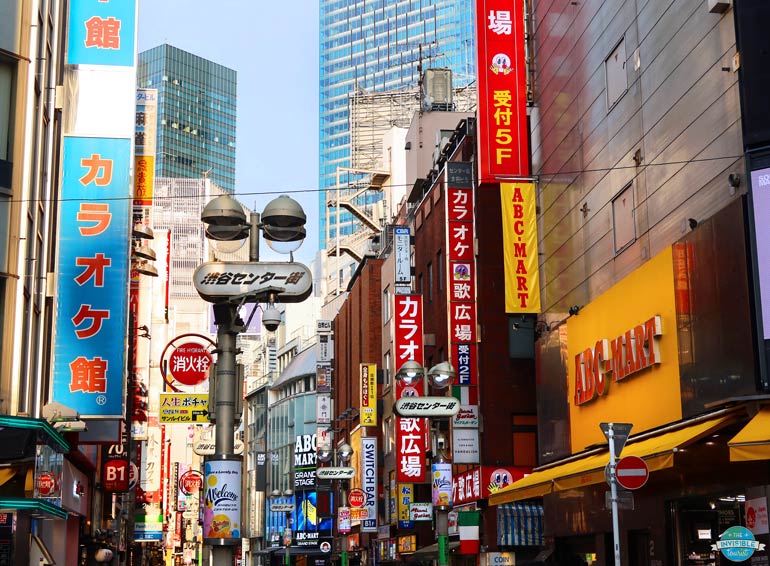
Enjoying a Showa Era okonomiyaki restaurant
The buildings of early Showa Era in Japan (1926 – 1989) are still dotted throughout Tokyo, despite the city undergoing significant damage during the firebombing of WWII. This period outside of wartime brings a welcome nostalgia for locals, and our next stop demonstrated this beautifully.
Founded by a famous Japanese enka singer, this Shibuya restaurant specialises in okonomiyaki and teppanyaki. Having grown up in Osaka, on moving to Tokyo the singer missed her family. She opened the restaurant to cook and remind her of her mother’s okonomiyaki restaurant, where she had worked in her younger years.
The decor is beautiful and the okonomiyaki delicious! I ordered a serving of sake as my alcoholic drink, which was so pure and on the sweeter side.
The final surprise was awaiting us next door – a stunning bar and karaoke room. Take note of the little things that hint to the singer’s Kansai background.
TIP: Both Osaka and Hiroshima have their own versions of okonomiyaki, resulting in a friendly rivalry. Read my guide about things to do in Hiroshima and my Osaka itinerary for more info.

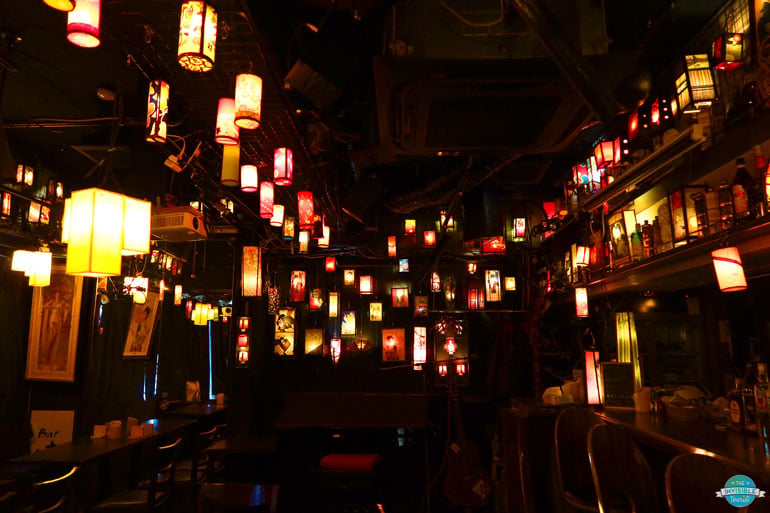
Finishing with a traditional Japanese street food dessert
Remember earlier how I said Shibuya is also a vertical city? Down in the basement of Shibuya Station, we wrapped up the tour with a traditional Japanese dessert.
Passing through the underground maze of eateries, we arrived at an imagawayaki store – a Japanese filled pancake. Through the glass we could see them cooking away, different fillings resting on the bubbling batter before a second pancake enclosed the treat.
I chose matcha and anko (red bean paste). The aroma of pancakes cooking right beside us made me forget about my full stomach… There is always room for dessert, right?
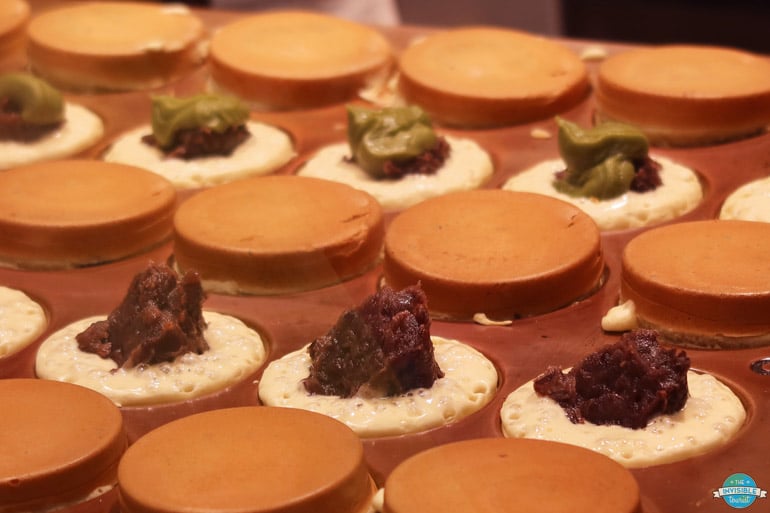
How to book your own Shibuya Street Food Tour
If this Shibuya Street Food Tour a must for you, click here for prices and to book! Remember to allow 3 hours for this experience.
The best Tokyo street food? Final thoughts on this Shibuya food tour
What I liked about this tour was the huge variety of food (well, obviously), and that there was a lovely balance of briefly being shown popular spots you can return to at your leisure another time, and hidden spots I would never have found on my own.
As with other Arigato Japan tour guides, my Shibuya food guide Norma was so friendly, easy to chat to and made this tour so much fun!
If you’re wanting to get beneath Shibuya’s modern façade and learn more about Japanese street food, I’d definitely recommend this tour. As I’ve mentioned earlier, I’ve seen more of Shibuya than the average tourist and I was delighted to learn about lesser-known gems on the tour.
Sending a huge thanks again to Arigato Japan Tours for inviting me on this wonderful experience!
While you’re here, why not check out all my travel guides and itineraries for Japan? I’ve also shared how to plan a trip to Japan, what to pack for Japan in every season, crucial Japanese etiquette, easy Japanese phrases for tourists (including a FREE cheat sheet) and more!
If you found this helpful please share it with your friends or come and join me on Facebook, Pinterest, Instagram and TikTok for more Japan inspiration!
Until next time,

Like it? Pin it! 📌
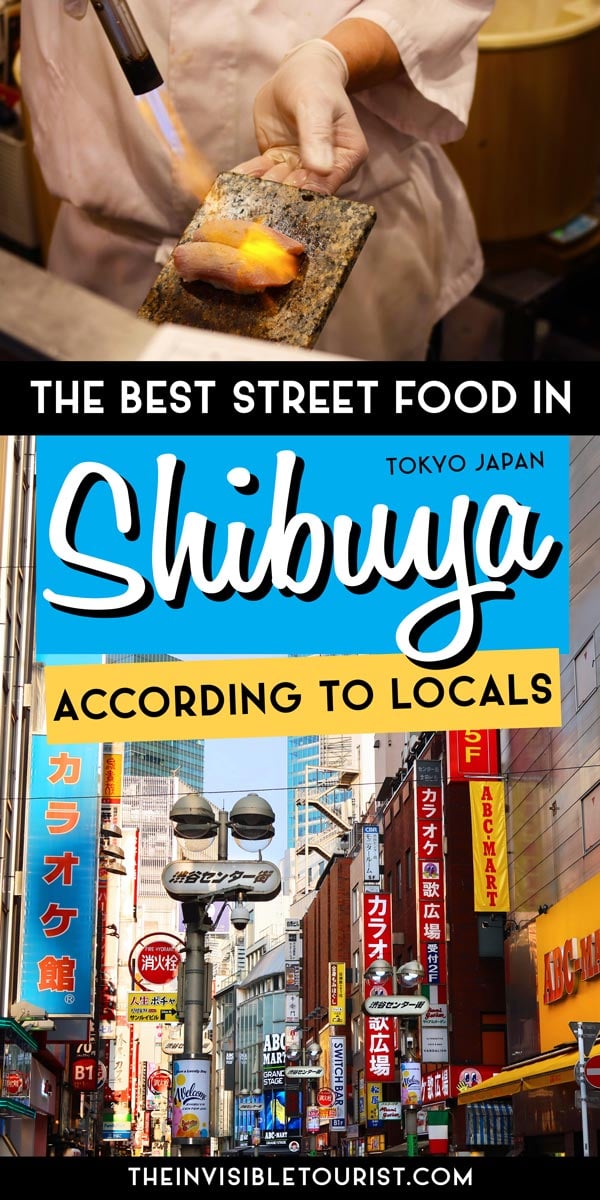
This guide to street food in Shibuya contains some affiliate links, at no extra cost to you. I may earn a small commission if you decide to make a purchase and if you do, thanks for your support! This helps with the costs of running my blog so I can keep my content free for you. As always, I only recommend a product or service that I genuinely love and use myself!
Australian-based Alyse has travelled "The Invisible Tourist Way" for thirteen years and hopes to encourage fellow travellers to do so, too. Based on her travels to 260+ cities across 32 countries, through her blog she shares passionate advice about responsible travel, history and preserving local cultures for more enriching experiences. Her dreams? Always about the next destination and how to make the most of it by "blending in".

 Lynk
Lynk 































